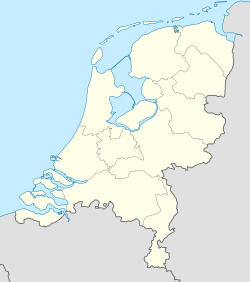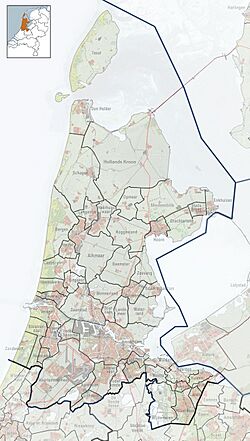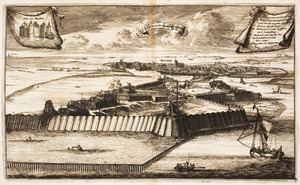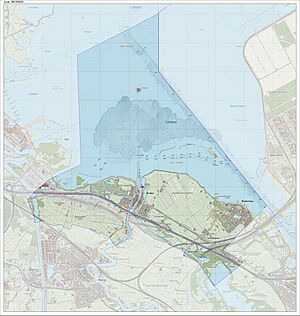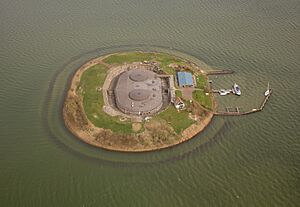Muiden facts for kids
Quick facts for kids
Muiden
|
|||
|---|---|---|---|
|
City and former municipality
|
|||
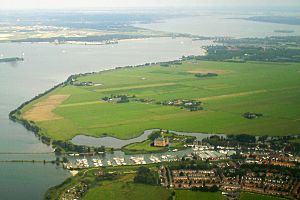
Aerial view of Muiden and Muiderslot
|
|||
|
|||
| Country | Netherlands | ||
| Province | North Holland | ||
| Municipality | Gooise Meren | ||
| Area | |||
| • Total | 13.07 km2 (5.05 sq mi) | ||
| Elevation | 0 m (0 ft) | ||
| Population
(2021)
|
|||
| • Total | 7,200 | ||
| • Density | 551/km2 (1,427/sq mi) | ||
| Time zone | UTC+1 (CET) | ||
| • Summer (DST) | UTC+2 (CEST) | ||
| Postcode |
1398–1399
|
||
| Area code | 0294 | ||
Muiden is a historic city in the Netherlands. It is located in the province of North Holland. Muiden sits right where the Vecht River meets the water. This area is known as the Vechtstreek. Since 2016, Muiden has been part of a larger municipality called Gooise Meren. It is well-known for its famous castle and its important role in Dutch history.
Contents
History of Muiden
Early Beginnings
The first time Muiden was mentioned was in the year 953. At that time, Otto I, Holy Roman Emperor gave the settlement and its right to collect tolls to the Cathedral of Saint Martin, Utrecht. A toll is a fee paid to use a road or bridge. The city was first called Amuda. This name meant "mouth of the (river) A", where "A" was the old name for the Vecht River.
City Rights and Castle Building
In 1122, Muiden was given some city rights by Emperor Henry V. City rights allowed a place to govern itself more. Later, the lands around Muiden were given to Count Floris V. He started building Muider Castle right at the mouth of the Vecht River. Muiden received its city rights again in 1296.
Defensive Structures
The first defenses in Muiden were built in the early 1400s. In 1590, the old walls were replaced. New earthen mounds with bastions were built. Bastions are strong parts of a fort that stick out. This new design was made by Adriaen Anthonisz. Muiden was the northern end of the important Dutch Water Line. This was a line of defenses that used water to protect the country.
In 1673, a sea lock in the Vecht River was moved to Muiden. A sea lock is like a gate that controls water levels. In 1676, a sea wall was added along the Vecht mouth. This was to stop flooding.
Modern Fortifications
After the Franco-Prussian War in 1870, new ways of fighting meant Muiden needed updates. New forts were built as part of the Stelling van Amsterdam. This was a defense line around Amsterdam. These new parts included the Muizenfort, barracks (buildings for soldiers), and casemates. Casemates are armored rooms in a fort. The design of the fortification wall was also changed.
Fort Pampus Island was built from 1887 to 1897. It was part of the former municipality of Muiden. This artificial island, along with a lighthouse island and an artillery battery (a group of cannons) at the Diemer seawall, helped protect the entrance to the IJ Bay and Amsterdam's harbor.
Geography
The former municipality of Muiden had two main areas where people lived. These were Muiden itself and Muiderberg.
Attractions
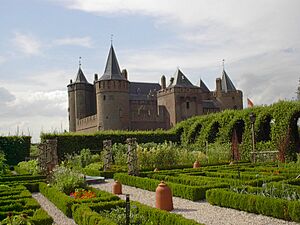
Muiden has several interesting places to visit:
- Muiderslot (Muider Castle): This is a very old and well-kept castle from the Middle Ages.
- Muizenfort (Mice Fort): This fort was built in the 1800s. It is part of the Stelling van Amsterdam, a famous defense line.
- Fort Pampus Island: This is an island made by people. It is also part of the Stelling van Amsterdam, which is also called the Defence Line of Amsterdam.
Many walking and cycling paths go through Muiden. These paths let you explore the beautiful region.
Gunpowder Factory History
In 1702, making gunpowder was moved out of Amsterdam. It was a dangerous process. The city leaders of Muiden allowed Reinier van Cuyk to build a gunpowder factory. It was built just west of Muiden in the same year.
The factory did very well during the First World War. It closed for a short time in 1919 but reopened in 1922. During the 1900s, it grew bigger and made more gunpowder. The town of Muiden also grew closer to the factory. In 1972, its name changed to "Muiden Chemie". The factory faced various safety concerns over the years. After a fire in 2001, it was decided to close the factory for good.
Over the years, there were several incidents at the factory. These events sometimes caused damage to the factory and the town of Muiden. For example, a large explosion happened in 1883. Other incidents occurred in 1886, 1924/1925, 1947, 1948, 1949, 1963, 1966, 1972, and 1983. The fire in 2001 was the last major incident before the factory closed.
Notable people
- Abraham Samson Onderwijzer (1862–1934), a rabbi and someone who helped start labor unions.
See also
 In Spanish: Muiden para niños
In Spanish: Muiden para niños




